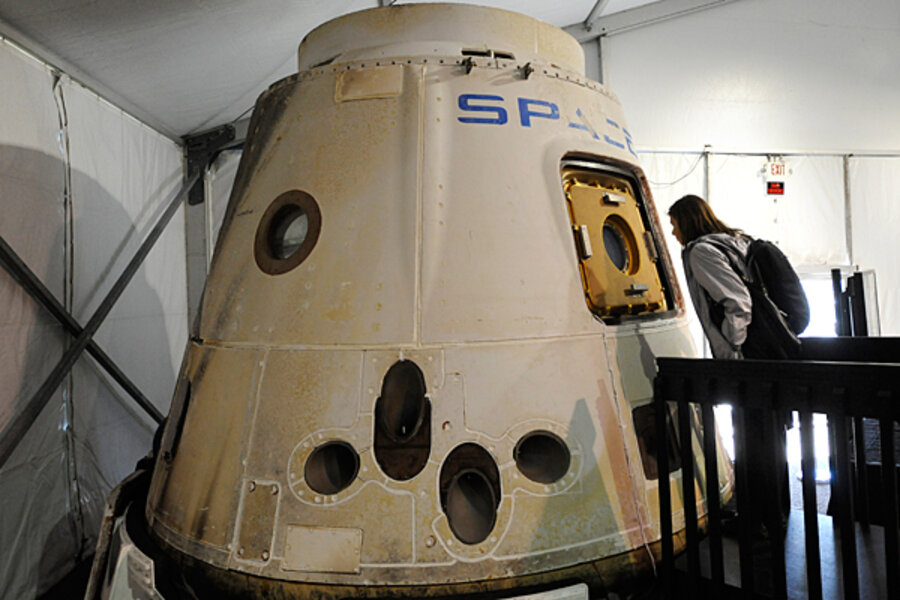In race to replace space shuttles, NASA boosts four front-runners
Loading...
Efforts to develop new spacecraft to ferry astronauts to and from the International Space Station have picked up fresh momentum thanks to agreements NASA has reached with four companies aiming to become the Checker Taxis to low-Earth orbit.
Space-agency officials announced late Monday that they would be spending $269.3 million this year to help four companies refine their concepts and hardware. The quartet, which was whittled down from a list of 22 proposals, ranges from long-time aerospace player Boeing to a new generation of aerospace entrepreneurs, including Space Exploration Technologies (SpaceX) and Blue Origins, founded by Amazon.com's Jeff Bezos.
The announcement comes at a critical time in the evolution of the US human-spaceflight program.
On April 29, the space shuttle Endeavour is scheduled to lift off from the Kennedy Space Center in Florida on its final mission. In late June or early July, Atlantis makes its farewell flight, bringing the 30-year shuttle program to a close. With no US replacement for the shuttle standing ready to pick up the baton, US astronauts will be traveling to and from the station in Russian spacecraft at least through 2016.
Eventually, though, the Obama administration's plan is to have private companies take up where the shuttle left off – ferrying equipment and crew to the space station and low-Earth orbit. NASA, then, would be free to focus on more ambitious missions farther into space.
Some analysts suggest it would be cheaper to continue piggybacking with the Russians into low-Earth orbit, while some members of Congress are loath to have NASA cede that task to anyone else – the Russians or private contractors. But the with its announcement Monday, NASA took another step forward on the president's plans.
And the winners are...
It is as yet unclear how many of the proposals NASA might ultimately choose. But they include:
• SpaceX, based in Hawthorne, Calif, is slated to get $75 million to turn its Dragon capsule into a vehicle fit for humans as well as cargo. The capsule is designed to sit atop the company's new Falcon 9 rocket. Space X has had one successful test flight of the Falcon 9 and Dragon capsule in December. The rocket delivered the capsule to orbit, and after two trips around the Earth, the capsule splashed down in the Pacific off of Mexico and was recovered. SpaceX, which already is under a $1.6 billion contract with NASA to deliver cargo to the space station, aims to ferry its first crew in 2014.
• Boeing stands to pick up $92.3 million if it meets its benchmarks over the next year. The company's Commercial Crew Transportation System 100 concept involves a reusable capsule that could be used with a range of existing commercial rockets, most of which have well-established records for reliability. Boeing aims to have a full launch-to-splashdown system ready by 2015.
• Sierra Nevada Corporation, in Louisville, Colo., will pick up $80 million to advance it's "Dream Chaser" crew vehicle – a mini-shuttle capable of carrying a crew of seven. Like the shuttle, Dream Chaser is being designed to glide to a runway landing.
• Blue Origin, a company in Kent, Wash., founded by Amazon.com founder Jeff Bezos, has been awarded $22 million for work on its capsule-like craft. Initially the company plans to launch it on an Atlas rocket, then shift to its own rocket, which also is under development.
The selection marks the second phase of NASA's effort to foster commercial carriers for astronauts. Three of the four companies named yesterday also split an initial $20 million in NASA seed money in February 2010. Companies also are contributing money from their own checkbooks to participate in this phase of the program to develop commercial crew transportation.
Cost savings?
The overall aim of the program is to significantly reduce the cost of lofting people and payloads into space. Yet an analysis by the Aerospace Corporation of El Segundo, Calif., suggests that launches on commercial vehicles – while cheaper than a NASA program – could still cost two to three times more than extending contracts with "foreign-based alternatives," alias the Russians.
The analysis drew immediate fire from the Commercial Spaceflight Federation, which strongly favors the current NASA approach. The federation criticized the findings for a lack of on-the-ground information from the companies on where their technology stands and what their business plans are, and a failure to consider a full range of potential customers, including astronauts from other countries.
Meanwhile, NASA is pressing ahead, although the specifics of what comes after this phase of the program have yet to be determined.
In general, however, NASA officials say Part 3 in this saga likely will focus on proposals for launch-to-landing concepts for a commercial crew-transport system – a process that will be open to all comers and not merely the four companies receiving seed money for the next 12 months.





